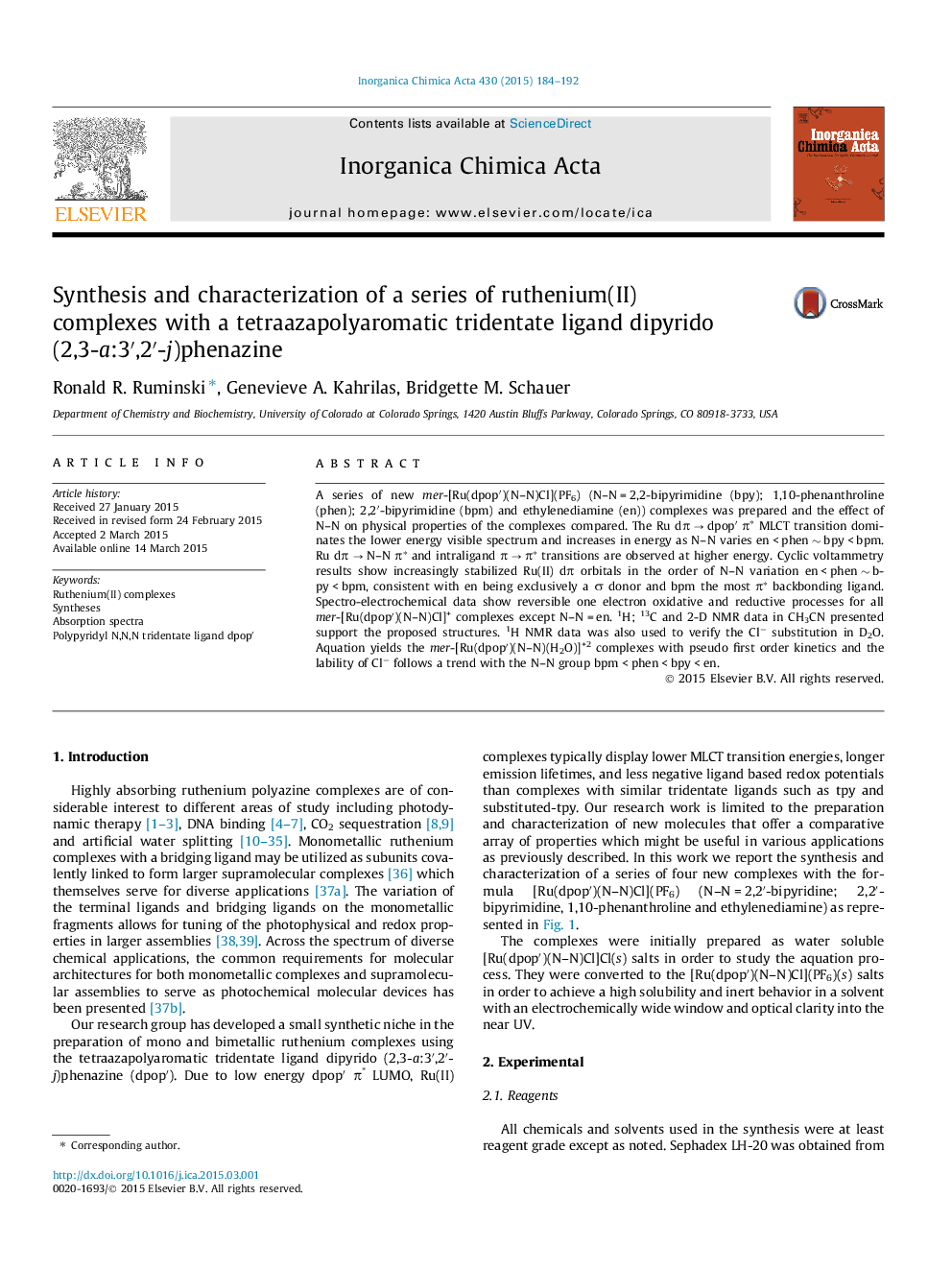| Article ID | Journal | Published Year | Pages | File Type |
|---|---|---|---|---|
| 1309124 | Inorganica Chimica Acta | 2015 | 9 Pages |
•Synthesis of a series of new Ru(II) mixed ligand polyazine chloro complexes.•Absorption, electrochemical, NMR and kinetic data.•The effects of the strongly π∗ withdrawing ligand dpop′ on physical properties.
A series of new mer-[Ru(dpop′)(N–N)Cl](PF6) (N–N = 2,2-bipyrimidine (bpy); 1,10-phenanthroline (phen); 2,2′-bipyrimidine (bpm) and ethylenediamine (en)) complexes was prepared and the effect of N–N on physical properties of the complexes compared. The Ru dπ → dpop′ π∗ MLCT transition dominates the lower energy visible spectrum and increases in energy as N–N varies en < phen ∼ bpy < bpm. Ru dπ → N–N π∗ and intraligand π → π∗ transitions are observed at higher energy. Cyclic voltammetry results show increasingly stabilized Ru(II) dπ orbitals in the order of N–N variation en < phen ∼ bpy < bpm, consistent with en being exclusively a σ donor and bpm the most π∗ backbonding ligand. Spectro-electrochemical data show reversible one electron oxidative and reductive processes for all mer-[Ru(dpop′)(N–N)Cl]+ complexes except N–N = en. 1H; 13C and 2-D NMR data in CH3CN presented support the proposed structures. 1H NMR data was also used to verify the Cl− substitution in D2O. Aquation yields the mer-[Ru(dpop′)(N–N)(H2O)]+2 complexes with pseudo first order kinetics and the lability of Cl− follows a trend with the N–N group bpm < phen < bpy < en.
Graphical abstractA series of new mer-[Ru(dpop′)(N–N)Cl](PF6) (N–N = 2,2-bipyrimidine (bpy); 1,10-phenanthroline (phen); 2,2′-bipyrimidine (bpm) and ethylenediamine (en)) complexes was prepared and the effect of N–N on physical properties compared. The Ru dπ → dpop′ π∗ MLCT transition dominates the lower energy visible spectrum and increases in energy as N–N varies en < phen ∼ bpy < bpm. Ru dπ → N–N π∗ transitions are observed at higher energy. Cyclic voltammetry results show increasingly stabilized Ru(II) dπ orbitals in the order of N–N variation en < phen ∼ bpy < bpm, consistent with en being σ donor and bpm the most π∗ backbonding ligand. Spectro-electrochemical results show one electron oxidative and reductive processes are reversible, except for [Ru(dpop′)(en)Cl]+ that undergoes irreversible oxidative dehydrogenation of en. 1H; 13C and 2-D NMR data presented support the proposed structures. The rate of aquation of the chloride ion was measured at 310 K and the first order rate constant kH2OkH2O increases with N–N = bpm < phen < bpy < en. The chloride replacement in D2O to produce the [Ru(dpop′)(N–N)(D2O)]+2 was verified by 1H NMR spectral changes.Figure optionsDownload full-size imageDownload as PowerPoint slide
